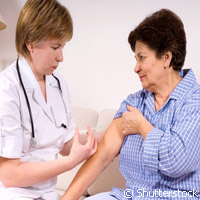Study finds H1N1 vaccine largely effective last winter
A single dose of vaccine against A(H1N1) pandemic influenza provided a good level of protection against the disease during the winter flu season 2009-2010, new research shows. The vaccine was particularly effective in those aged under 65 and in people without chronic conditions. The findings, published in the journal PLoS Medicine, offer an insight into the effectiveness of this winter's vaccine, which is designed to offer protection against H1N1 as well as other strains of influenza. Early indications are that H1N1 is the predominant strain in circulation this winter. The study was funded by the European Centre for Disease Prevention and Control (ECDC), an EU agency set up in 2005 to help Europe defend itself against infectious diseases. When the World Health Organization (WHO) declared the outbreak of A(H1N1) influenza (also known as swine flu) a pandemic in June 2009, the European Commission quickly granted marketing authorisation for three pandemic vaccines to be used in EU countries. Early tests demonstrated that these vaccines provoked strong immunological responses after the first dose. However, as the researchers point out, a strong immunological response does not always mean that the vaccine will be effective, so it is important to gauge a vaccine's effectiveness at the population level. In this study, scientists drew on data of primary care practitioners involved in the European Influenza Surveillance Network (EISN) to assess levels of A(N1N1) vaccine effectiveness in seven countries (Ireland, Spain, France, Italy, Hungary, Portugal and Romania) during the 2009-2010 flu season. Participating practitioners took a nasal or throat swab from patients suffering from influenza-like illness. Swabs were tested for influenza at the relevant National Influenza Reference Laboratory. Information was also gathered on if and when the patient had been vaccinated against A(H1N1) and/or the seasonal flu strain circulating in 2009-2010. Other data gathered included the patient's age and sex as well as the presence of chronic conditions, pregnancy, obesity and smoking status. The authors analysed the data carefully, breaking down the patients into 4 groups based on their vaccination status: those who had been vaccinated more than 14 days before the onset of symptoms; those who had been vaccinated between 8 and 14 days before falling ill; those who had been vaccinated fewer than 8 days before the onset of symptoms; and those who had never been vaccinated. Their analyses revealed that a single dose of the A(H1N1) vaccine offered good levels of protection (between 65% and 100%) against the disease. The vaccine was particularly effective in the under 65s and in people without chronic diseases. Furthermore, the vaccine appeared to offer some protection from as early as eight days after vaccination. The study also confirmed that the general seasonal flu vaccine in use in the 2009-2010 flu season did not offer protection against the A(H1N1) strain. However, the authors of the paper note that their findings must be treated with some caution. 'Our results suggest good protection of the pandemic monovalent vaccine against medically attended pH1N1 and no effect of the 2009-2010 seasonal influenza vaccine,' they conclude. 'However, the late availability of the pandemic vaccine and subsequent limited coverage with this vaccine hampered our ability to study vaccine benefits during the outbreak period. Future studies should include estimation of the effectiveness of the new trivalent vaccine in the upcoming 2010-2011 season, when vaccination will occur before the influenza season starts.' Commenting on the findings, Bruno Ciancio, one of the authors of the paper and the ECDC's senior flu expert, said: 'This study showed the added value of collaboration at European level as concerns vaccine evaluation. In addition, the results obtained are especially important for European countries this season, considering that the predominant influenza strain currently circulating across Europe is influenza A (H1N1).' The latest figures from the ECDC show that high levels of influenza activity are being reported in Denmark, Ireland and the UK, where England is particularly affected. Medium levels of activity are reported in Belgium, France, Italy, Luxembourg, Malta, Norway, Portugal, Spain and the rest of the UK.For more information, please visit: PLoS Medicine:http://www.plosmedicine.orgTo access the paper, please click:http://www.plosmedicine.org/article/info%3Adoi%2F10.1371%2Fjournal.pmed.1000388 (here)European Centre for Disease Prevention and Control (ECDC):http://www.ecdc.europa.eu/ World Health Organization (WHO):http://www.who.int/en/
Countries
Spain, France, Hungary, Ireland, Italy, Portugal, Romania



